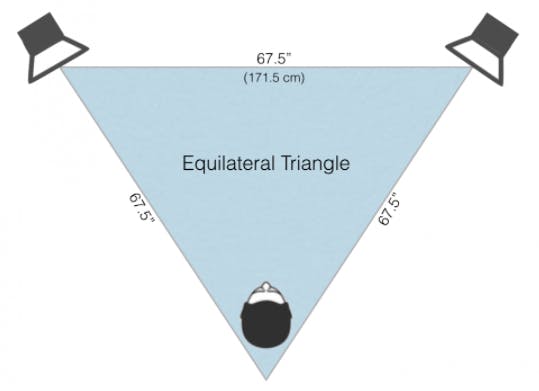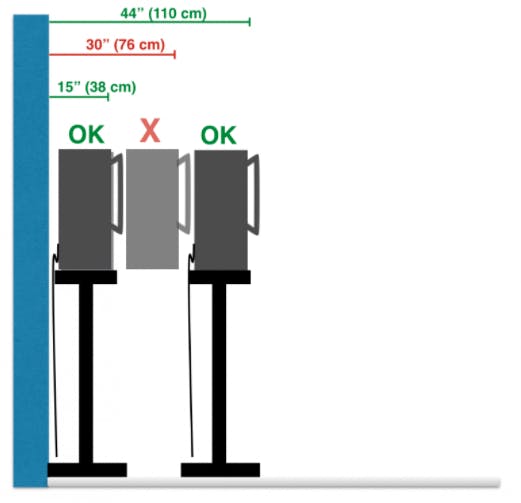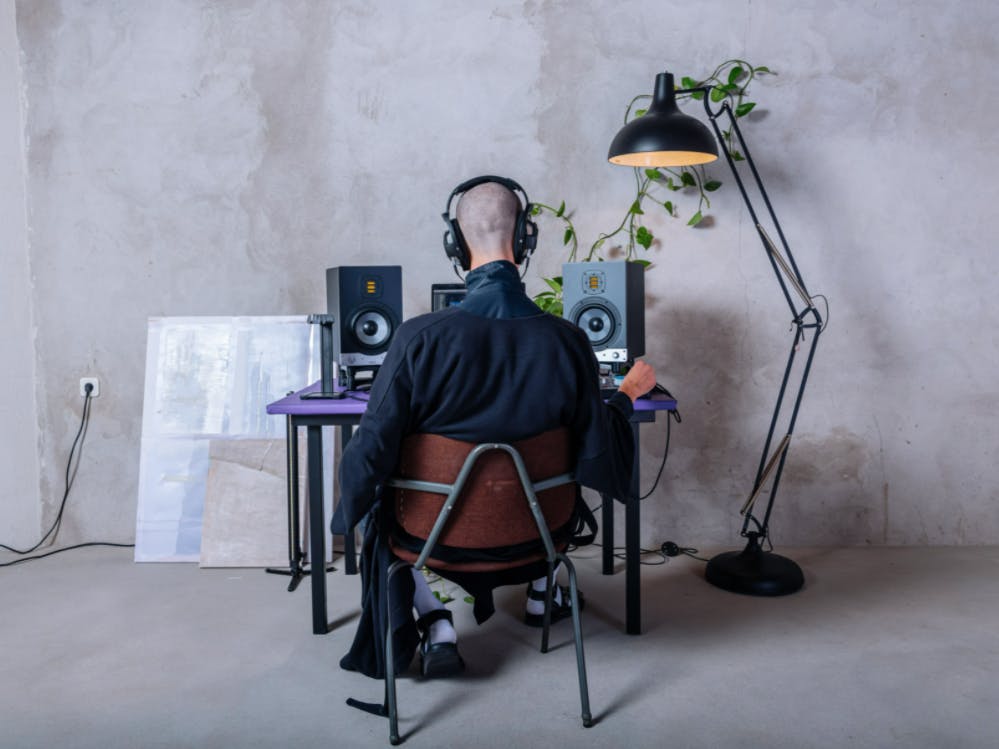Where and how you place your speakers (and listening positions) in your studio determines how well you achieve an accurate frequency response and a solid stereo image. Ideally, your listening position and the two monitors form an equilateral triangle. In other words, the distance between the left and right speakers and the distance from each speaker to the back of your head should be equal. A tape measure, a piece of string, or even a guitar cable will help you set up this triangle. There are some recommended starting measurements for the triangle, but it is most important that each side is the same length.
Speaker Placement and Geometry
Studio monitors sound their best when listened to on-axis, so it is also important to ensure the monitors point directly at, actually slightly behind, your head. High frequencies are more directional than lower frequencies so you may not hear the high frequencies accurately if you are listening to speakers pointing too far off-axis. This may differ for a particular speaker, but in general, we want the speakers to point directly towards our ears—and we want to minimize the high frequencies that bounce off the side walls. As for height, ideally, the tweeters should be at the same height as your ears when you are seated, typically about 47-55 inches (120-140 cm) from the floor. Speakers can be placed slightly higher and tilted down towards you if you need to clear the top of your computer monitor. Tilting speakers is a precarious way to set up the monitors and care must be taken to avoid the speakers toppling over.

Noted acoustician Carl Tatz recommends nearfield speakers be spaced 67.5 inches (171.5 cm) apart, but even he agrees that this is only a starting point. Most recording consoles are about 48 inches (122 cm) deep, so for speakers sitting on the console’s meter-bridge, this setup creates an equilateral triangle with its focal point just behind the mixer’s head. This geometry produces a natural stereo image and sound will seem to exist in the room, rather than coming directly from the speakers themselves. If you have a small desk, speaker stands will help position the speakers to create the optimum geometry. If your room forces you to sit closer to your front wall, you can simply move the monitors closer together to achieve something close to an equilateral triangle. If your speakers are physically large, a larger triangle will probably make sense, and vice versa.
Can You Place Speakers Against the Wall?
Try to place your monitors either almost against the front wall or at least 43 inches (110cm) away from the front wall. If your speakers are placed close to the front wall, their bass response will be exaggerated by up to 6dB. For this reason, many monitors provide onboard EQ settings such as whole-space (flat EQ for placement away from any walls), half-space (slight bass reduction for placement near the front wall), and quarter-space (increased bass reduction for placement near front corners). Many monitors also provide additional EQ options, which can further tailor the speakers’ sound to compensate for deficiencies in the listening environment. Keeping symmetry in mind, the left and right speakers should ideally be equidistant from their respective side walls.
If your speakers have a rear port, just keep the speakers away from the wall at least the same distance as the diameter of the port, usually about 5 to 10 centimeters. Speakers placed with their front surface more than 15 inches (38 cm) and less than 44 inches (110 cm) from the front wall run the risk of creating uneven bass response due to low-frequency reflections from the front wall. Similarly, try to place your speakers at least 44 inches from their nearest side wall. If your speakers must be placed near a side wall or a corner, try the quarter-space EQ setting on the speaker to mitigate any extra bass build-up. You will, of course, need some acoustic treatment on the front and side walls, so leave at least a few inches for that. For a more thorough look at speakers/wall interactions, check out the links at the end of this article.

Setting up A Subwoofer
Subwoofers are non-directional, so placement is a bit less critical. A trick to help find a good location for a sub is to temporarily put the subwoofer in your listening position and crawl around the room to find where the bass sounds best, mark that location and place your subwoofer there. Your subwoofer may have a cutoff or crossover frequency control, which should be adjusted to match the bass roll-off of your particular main monitors. Refer to your monitors and subwoofer user guides to determine their optimal crossover frequency.
The idea of a subwoofer is to take away the hard work of creating low frequencies from the smaller main speakers, so if the crossover point is set too low, perhaps below 70Hz, some smaller main monitors may still struggle to handle the low frequencies. Conversely, subwoofers are not meant to handle anything but bass, so if you set your crossover above 100Hz, there’s a good chance your ears will be able to locate the sub and your stereo image may suffer. One question I often hear is “is one subwoofer enough?” Good question.
Occasionally we run into the problem of localizing a sub, which is hearing the precise location of a single subwoofer, and some people find this distracting. Two solutions can help with this situation. The crossover point between the sub and main speaker can be lowered to a frequency where you no longer localize the sound. This only works if your main speaker can handle frequencies well below 70 Hz. The second solution, which costs a bit more, but works very well, is to utilize two subwoofers and place them below the main speakers. This effectively creates a multi-way speaker on each side so that the subs’ energy comes from the same location as your main speakers. The limitation here is space and money.
Speaker Isolation Pads
It may be beneficial to decouple the speakers from their stands or the desk surface they are resting on. Otherwise, the desk or stands might vibrate and effectively absorb or amplify certain frequencies. Speaker isolation pads help mitigate vibrations and resonances by absorbing the vibrations before they can transfer to the furniture. Simple and inexpensive isolation pads are made of dense foam, like the Auralex Mopad, while multi-layer isolators, like Primacoustic’s Recoil Stabilizers, provide even more isolation. Other more sophisticated isolators, like those from IsoAcoustics, use techniques like non-resonant spring systems and provide isolation as well as height adjustment. At a minimum, moving your speaker off of your desk and onto stands will provide some amount of isolation and you won’t feel the speaker vibrations through your work surface. Additionally placing speakers on stands provides you with a better opportunity to fine-tune the positioning of the speakers.
Careful monitor placement and isolation will ensure that what you hear is the most accurate sound your speaker system can produce. Once your setup is optimized, you can employ electronic room correction, like Sonarworks SoundID Reference,to really dial in the final touches to your monitors. Also, be sure to check out our article on acoustic treatment techniques to get the most out of your acoustic space. Our article about placing speakers against the front wall shows some real-life frequency graphs to illustrate the importance of speaker placement, so be sure to check out the links below!
Many points have been discussed in this article and deeper information can be found in these articles:
Should You Place Your Speakers Against the Front Wall? by Adam Kagan
Finding and treating first-reflections by Adam Kagan
Planning your home studio for the best sound by Barry Rudolph
Dealing with low-frequency acoustic issues by Barry Rudolph



